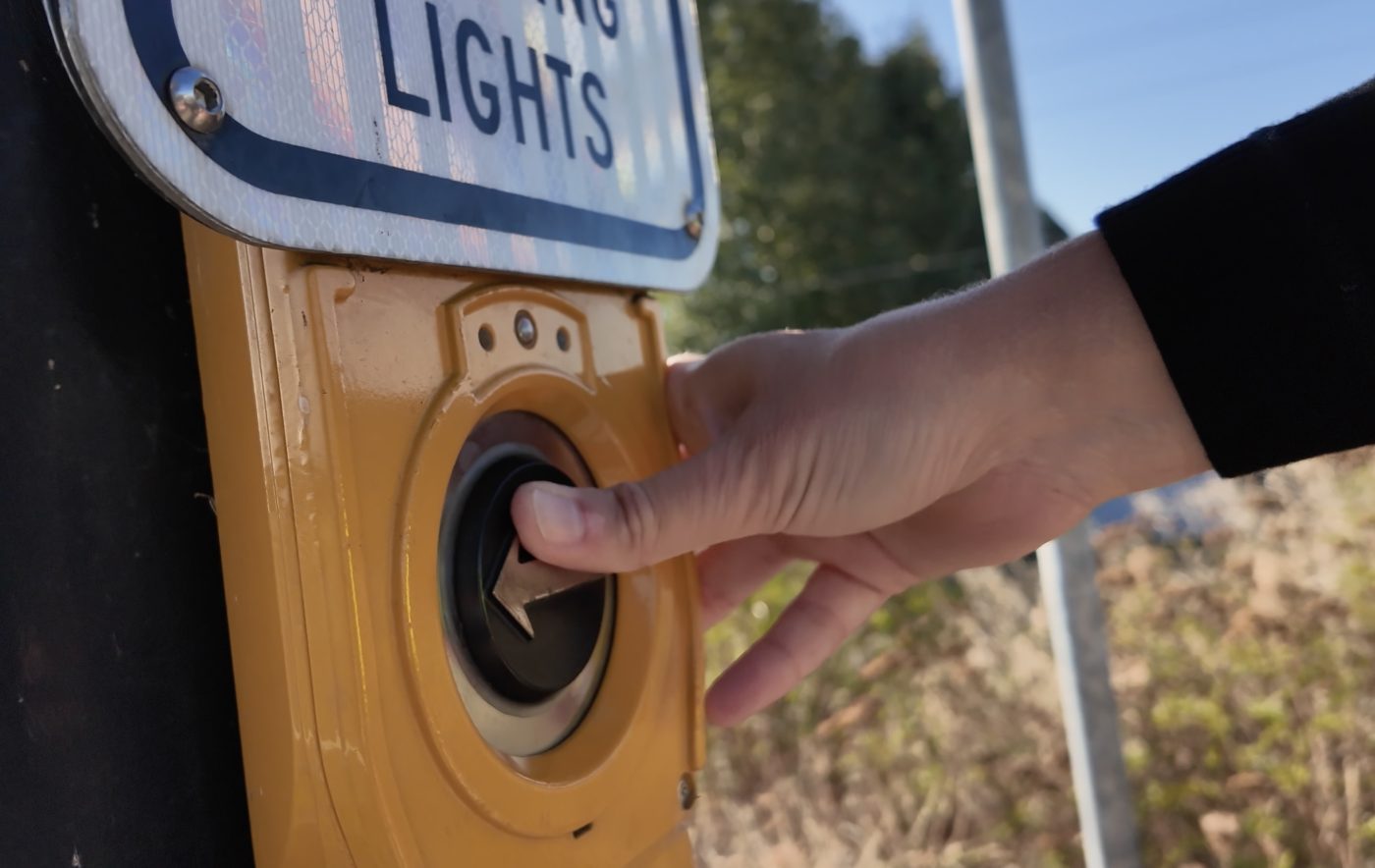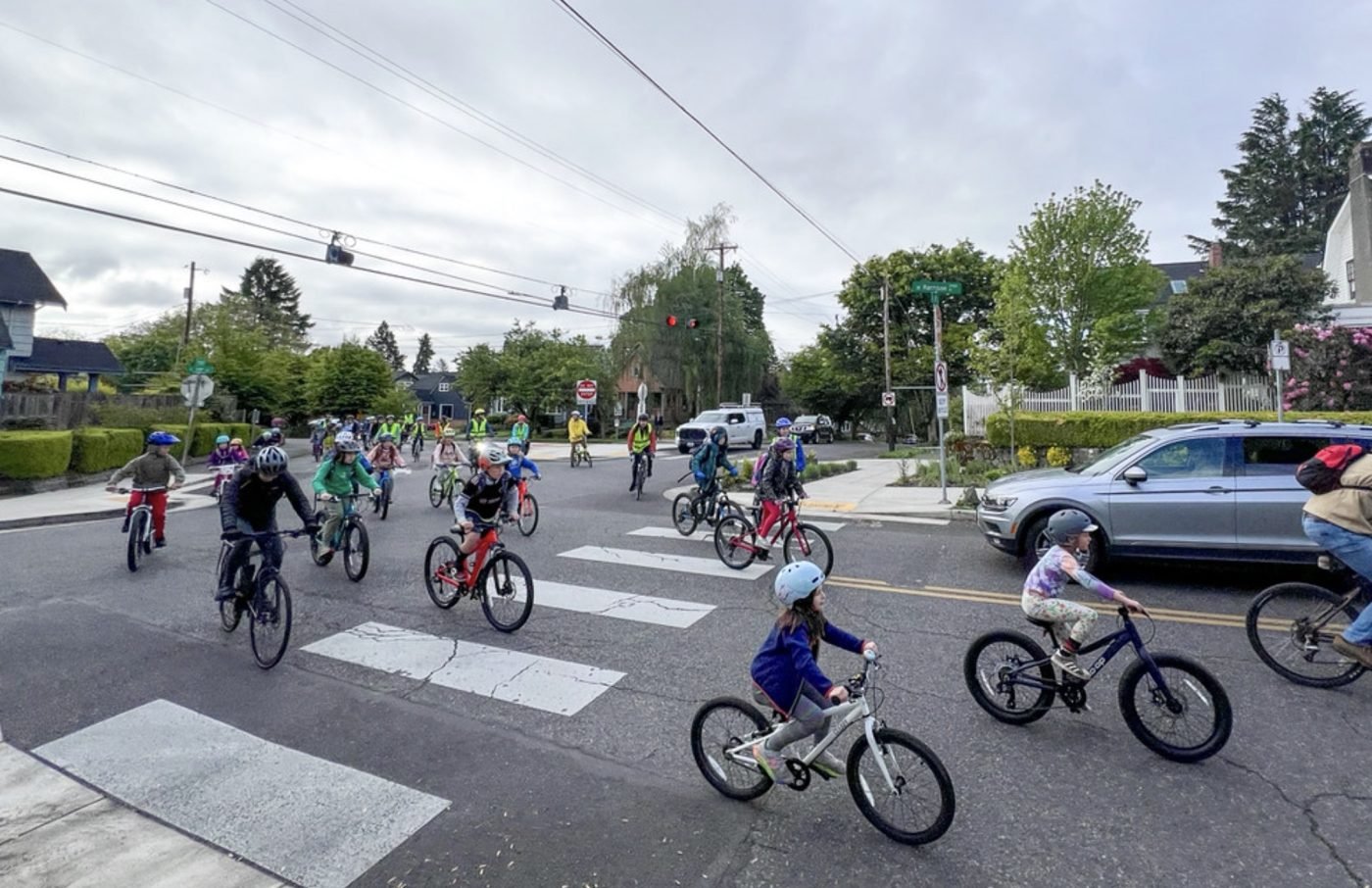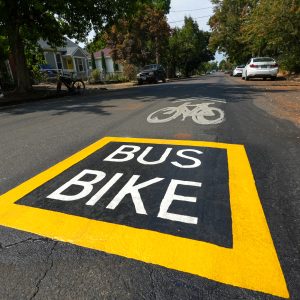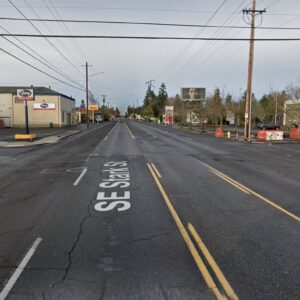
The latest illustration of how the City of Portland supports bike buses is a novel innovation that gives school ride leaders superpowers: At several locations across the city where bike bus routes cross busy intersections, the Portland Bureau of Transportation has programmed traffic signals with a custom, bike bus-friendly timing plan that is activated by a longer push of the beg button.
We’ve heard of transit signal priority to move buses through traffic. You could think of this as bike bus signal priority. I first heard about this from PBOT Director Millicent Williams when she spoke at the Bicycle Advisory Committee meeting last Tuesday. I then reached out to PBOT for clarification.
According to PBOT Communications Director Hannah Schaffer, signals engineers have re-programmed several traffic signals with added green “Walk” times that are initiated by a longer push of the pedestrian “beg” button. When activated, the new “Walk” signals give a significantly longer period of green crossing time than usual — in some cases over one minute (when combined with a shorter, flashing “Don’t Walk” signal), compared to just 10-15 seconds for a typical “Walk” signal. The extended walk signals are available for only a short window of time during the morning bike bus commute.
Below are just three examples Schafer was able to share with BikePortland:
- Location: SE Division at SE 80th. Timeframe: 7:00 to 8:15 am. Push and hold the pedestrian button crossing on SE Division to receive an extended walk up to 45 seconds (plus another 18 seconds flashing “Don’t Walk”)
- Location: SE Powell at 71st/72nd. Timeframe: 7:00 to 8:30 am. Push and hold the pedestrian button crossing Powell to receive an extended walk up to 45 seconds (plus 15 seconds flashing “Don’t Walk”). This also activates a pedestrian extension timer at 72nd and Powell crossing Powell, so these two intersections can stay red for Powell and allow for the bike movements heading south to east to south.
- Location: SE Holgate at 72nd. Timeframe: 7:15 to 8:30 am. We’ve installed a specific button on the NW corner that shows a “bike” symbol on it. The pedestrian movement will be served every cycle, as usual, but if you push and hold this button it will extend the walk up to 55 seconds (plus 8 seconds flashing “Don’t Walk”). We’ve also installed a pedestrian head start [also known as a leading pedestrian interval, or LPI] at this location for the crossing of Holgate (delays vehicle green for 4 seconds, in this case, and gives pedestrian movements a “head start”).
Keep in mind, these traffic signals weren’t designed to accommodate this type of use-case. What we have here is a government agency empowering knowledgable staff to use existing technology to support adopted policy goals and provide better service for road users. Longer “Walk” times will allow bike buses to stay together and might reduce the need for “corking” intersections — an often stressful move where a volunteer steps in front of opposing traffic to make sure everyone gets through the intersection.
These novel new signal adjustments are just one way PBOT is supporting the growth of bike buses, which now happen weekly at 20-25 schools across Portland’s five school districts. In April BikePortland reported on $650,000 from various sources that has been earmarked for bike bus-related investments. This includes a new wayfinding and signage program, intersection daylighting adjacent to school campuses (which is currently happening at nine schools, with another nine to be completed by the end of the school year), modal filters, and other traffic calming projects.
Yesterday PBOT launched a new survey seeking input on where and how to spend that money. The email announcing the survey was titled, “Greenways were made for bike buses.” It’s an acknowledgment that, while the latest bike bus revolution is only a few years old, PBOT’s robust network of 122 miles of neighborhood greenways are the foundation that makes it possible.
“As we continue to have conversations about what we do to support the bike bus movement,” PBOT Director Williams said the BAC meeting last week, “some of that will require some changes.” “There is a deep interest in making sure that we do that well and do that right.”






Thanks for reading.
BikePortland has served this community with independent community journalism since 2005. We rely on subscriptions from readers like you to survive. Your financial support is vital in keeping this valuable resource alive and well.
Please subscribe today to strengthen and expand our work.
YEEESSSSSSS!!!!!
There’s several intersections in DC that have the usual 15 seconds of the walk signal, then start a countdown at 90.
Yes you read that correctly, a major vehicle thoroughfare has schools on it. In each case there are several lights within a block of each other. Now for fun let’s guess where the danger and subsequent inevitable traffic jams occur!
Huh?
Here in NC we bicycle advocates are always asking for longer cross-signals for the lessor street at busy intersections, for bicyclists and pedestrians. The usual responses we get from our local traffic engineers is that it will cause traffic to massively backup on the primary arterial, that emergency services can’t get through, etc – lots of lame excuses – but they never actually try it to find out if it actually does cause those issues or not. The other concern is that by backing up traffic, some a**hole will try to bypass the backed up traffic by traveling illegally the wrong way in the other set of traffic lanes – there’s plenty of such drivers out there – and kill or injure the pedestrians and bicyclists trying to cross.
It’s a neverending battle out there.
Seems like they’re mad that four or five cars will have to stop for a minute to let sixty children through
Each of these children being dropped off in a vehicle would cause more of a traffic jam as their parents clog the streets to and from the school. Or…we can allow A WHOLE MINUTE for dozens and dozens of children to pass through safely and get on with our day.
Well done PBOT Traffic Signals group!!
Thanks so much
The “invisible infrastructure” of signal timing used brilliantly. So smart! More of this.
This is really great news and a cool solution! I’d love to see those routes get more diverters as well.
What stops ne’er-do-wells (like me) from long-pressing the buttond during the morning or afternoon commute, just cuz I wanna?
In other words, the bike-bus leaders don’t have a special key or anything?
It only works during certain times of the day. But if you show then, press away!
I really do appreciate the signal timing division of PBOT. The recent changes they made to Madison approaching the Hawthorne Bridge have done a great job slowing drivers down in the early morning and make it real easy for me to adjust my pace to hit the lights without having to stop.
There is a similar hack that I have used for years. The commonality is school activity, group ride, and traffic signal. I have used it when leading fifth graders in Bike Education classes in Corvallis.
In left turn lanes at traffic signals (without a bike box) you’ll typically see the embedded sensor cable up near the crosswalk – a long rectangle. Frequently you’ll see another cable twenty or thirty feet farther back, often circular. When leading a group I always direct my sweep rider to put a wheel on that second sensor. The signal controller for the intersection interprets that as a longer line of traffic waiting for a left turn and responds with an extended time for the green arrow left turn signal.
Just the thing for getting a bunch of kid through without splitting the group.
I’m generally not a fan of looking to technology to fix problems that, at heart, need to be addressed through political courage and reallocating the built environment, but this is a great case of the people with technical expertise at PBOT knowing the tools they manage and adapting them to community need. I could easily see a world where the engineers would have no interest in doing anything beyond the default configuration. Thanks JM for highlighting this work by PBOT.